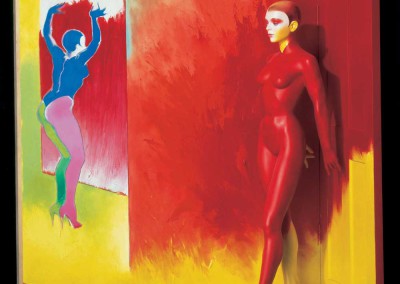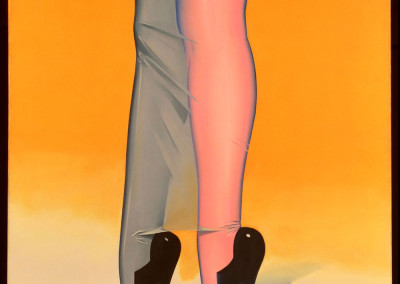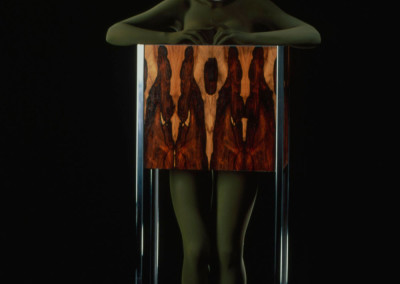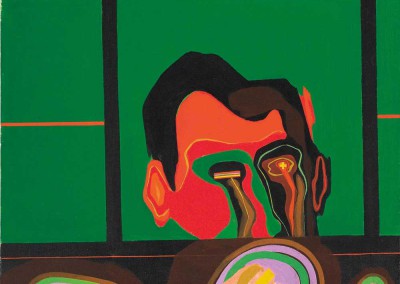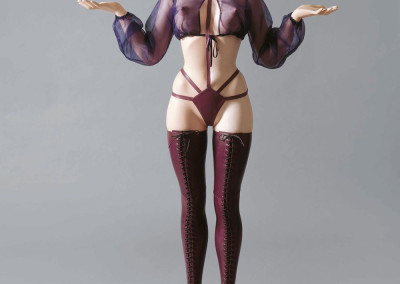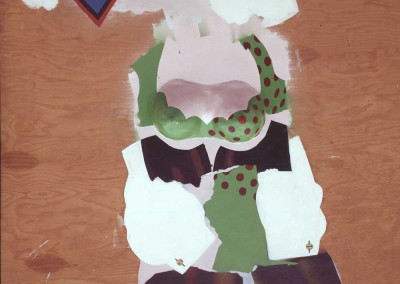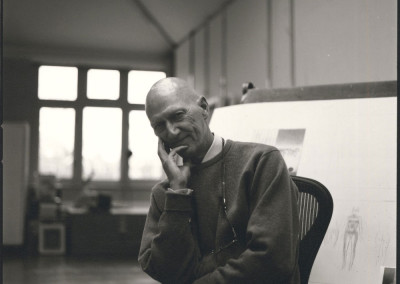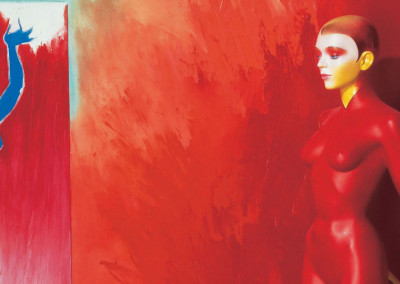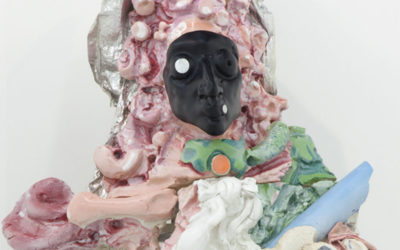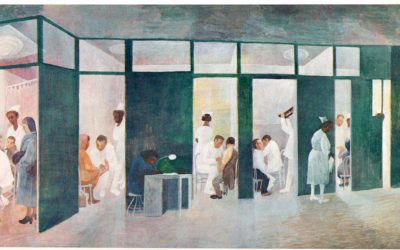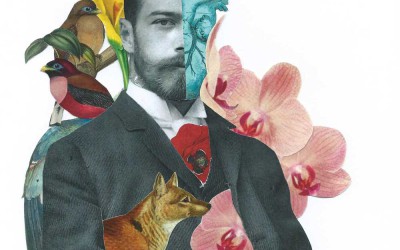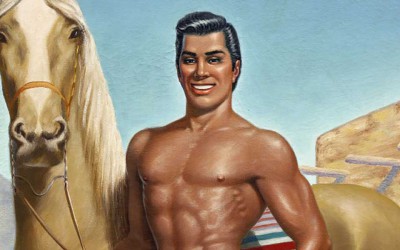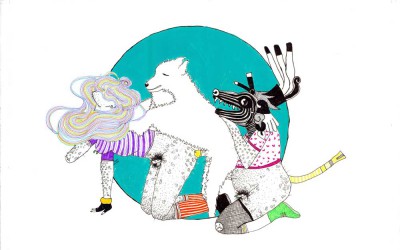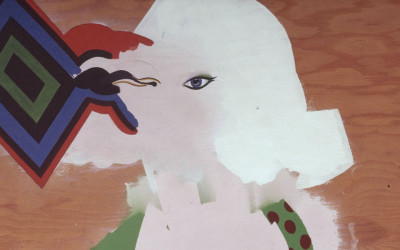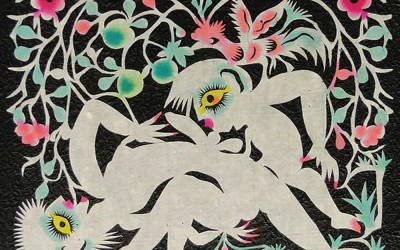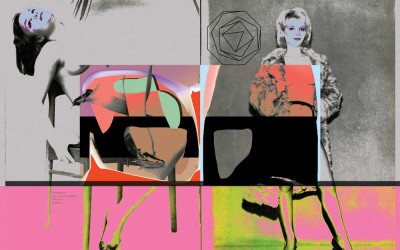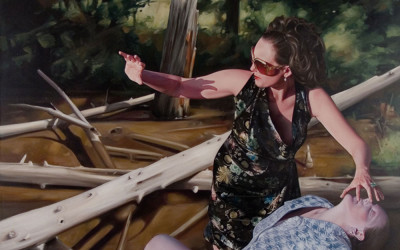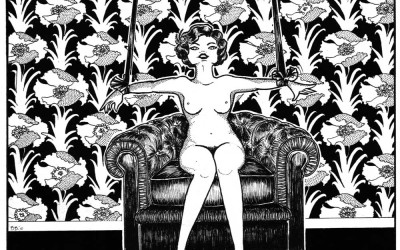From the moment I started at the academy I noticed that sculpting was very demanding on both a physical and a psychological level. This has never diminished. I very much like what I do, but a large percentage of my practice involves…..
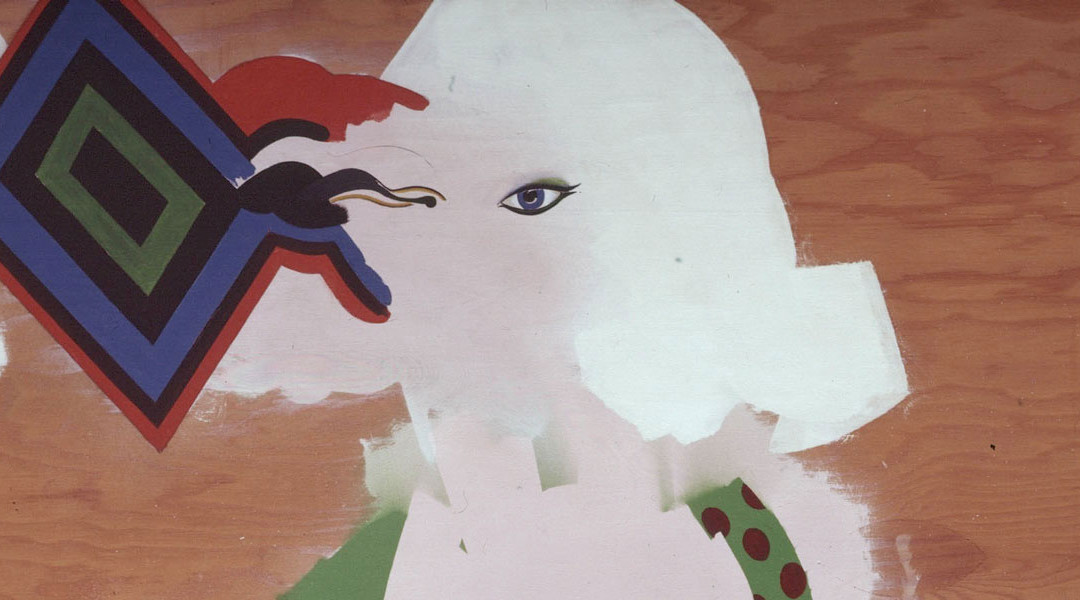
Allen Jones
Allen Jones
Text JF. Pierets Photos Courtesy of Royal Academy of Arts
Three women, wearing black leather fetish gear, produced by the same company that supplied Diana Rigg’s costumes in The Avengers. One of them is on all fours and the glass top on her back awaits your drink. The second one wears thigh high boots and is ready to collect your hat. The third one is offering herself as a chair. Allen Jones’ fetishist sculpture ‘Hat stand, table and chair’ is probably the piece of art that his name is likely to bring to mind.
It was 1969 when the British Pop Art artist designed these fibreglass models of submissive mannequins offering themselves as furniture. ‘Hat Stand, Table and Chair’ were an immediate international sensation and Jones was instantly labeled ‘a cultural hot potato’ when his work got attacked with stink bombs and caused a riot when first exhibited in 1970 at the Institute of Contemporary Art in London. Feminists where furious about the objectification of women and even The Guardian suggested it should be forbidden to exhibiting the items. Jones himself claimed, ‘I was living in Chelsea and I had an interest in the female figure and the sexual charge that comes from it. Every Saturday on the King’s Road you went out and skirts were shorter, the body was being displayed in some new way. And you knew that the following week somebody would up the ante.’ In retrospect, Jones feels, ‘I was reflecting on and commenting on exactly the same situation that was the source of the feminist movement. It was unfortunate for me that I produced the perfect image for them to show how women were being objectified.’
Zeitgeist
Fast forward to present day. As from November 13, 2014 till January 25, 2015, the Royal Academy of Arts will exhibit Jones’ work from the late 1960s up to the present day. The exhibition will be a survey of his work spanning his entire career, including prints, paintings and the iconic figurative sculptures. Over the past forty years his work has remained true to the depiction of popular culture, with much of his imagery being drawn from advertising and performance. But what about ‘Hat stand, table and chair’? Is the image still causing the same unease and emotional disturbance as it once did? Not long ago, in 1986 the sculpture attracted controversy once again. The Tate acquired ‘Chair’ in 1981 and in 1986, on International Women’s Day, two assailants poured paint stripper over the mannequin’s face. It’s assumed the action was a feminist protest, but those responsible were never caught. Are Allen Jones’ sculptures still sparking controversy after all these years? Or are we living in such a particular zeitgeist that we’re not giving in?
Gender stereotypes
Modern day feminist and founder of the wayward Belgian news site ‘De Wereld Morgen’, Bieke Purnelle, states that art should dare touch, accuse, expose and challenge: ‘Context is crucial in assessing images like that and I find it hard to understand that people tend to denounce provocative art, but don’t take any offence on the countless gender stereotypes that surround us on a daily base. Of course times are different now and you only have to look at advertisements published in the fifties to see how women’s role in society has changed. Yet I can’t help but noticing a return to the old deterministic stereotypes, for example when it comes to toys and children’s clothes. The perception of gender roles has a huge impact on how children and young people grow up. The properties that are assigned to the concept of ones gender are too much and too often emphasized to be comfortable. People get no room to just be an individual and are forced into a social straitjacket, while gender stereotypes, and by extension all stereotypes whether they concern gender, race or social class, are not only stupid and shortsighted, but also very dangerous.’
Moloko bar
‘A Clockwork Orange’ is brought into the discussion by Stella Bergsma. Writer and frontwoman of the band ‘EinsteinBarbie’; ‘there is a similar kind of art in ‘A Clockwork Orange’, one of my favorite movies of all times. Female bodies are used as tables in the Moloko bar. The first time I saw that, I thought it was kind of cool; the body as an object of desire.’ According to Martin Gayford from The Telegraph, Allen Jones got a call from Stanley Kubrick around 1970. The film director had seen an exhibition in which Jones had shown some extraordinary and disturbing pieces of sculpture. Kubrick thought they would be just the things for a scene in a new film he was planning, ‘A Clockwork Orange’. The trouble was, the director imagined that Jones would design his sets for no fee, just a credit. When I (Gayford) talked to Jones in his London studio recently, he told me that Kubrick had said: ‘I’m a very famous film director, this will be seen all over the world and your name will be known. ‘I held the phone away from my ear, I was just staggered anyone would say that. It showed an ego that dwarfed that of any artist I’ve known.’ Jones turned down the offer and a set designer produced the pieces in question (many continue to believe they were by Jones).
Men versus women
Besides from liking Jones’ objects, Bergsma also reacts when it comes to gender roles: ‘I am really not that bothered by the objectification of women because I think that objectification is a part of our sexuality, and as long as it is sort of a game it’s a quite natural phenomenon. But I would like to see more equality, I would love to see more male objects and I do dislike the fact that it is almost exclusively women that are objectified in our society. So it’s the inequality rather than the objectification that bothers me. Nevertheless, there is nothing to stop us from changing that. So as a Christmas present I would like to see men as Christmas trees. They have already got balls!’Whether objectification is a part of our sexuality or not, the fact remains that it’s quite difficult to stay ‘correct’ in such a matter. Writer and exploiter of the LGBT bookstore ‘’t Verschil’, Johanna Pas, takes it personal when she says: ‘Although I love looking at women as sexual beings, I think it’s important they’re being portrayed as acting, thinking creatures. Both in the arts as in advertising, in movies and everyday image formation. As a voyeur I would love to enjoy female beauty, yet our society turned that into a complex delight.’
‘Offensiveness in art is often a way to satirise injustice.’
Social inequality
Art holds a mirror to our society. Represents the social, economic, racial values of the time we live in and according to Charles Moffat, curator of the Lilith Gallery in Torronto, Allen Jones’ 1969 works were deliberately provocative: ‘I would argue ‘feminist’, because the goal behind the works was to draw attention to social inequality between the sexes. Photographer-Sculptor Cindy Sherman did something similar years later when she portrayed battered and beaten women as centrefolds in magazines, objectifying women who have been abused. The concept is simple: the artist is basically playing devil’s advocate (not quite, but close enough) and portraying women in such a way that it will provoke a sympathetic response to the plight of women. If we were to make a similar sculpture today, but use wax figures of minorities to make the furniture – it would provoke a similar response and make people more aware of how poorly minorities are treated. In 1969 Jones’ sculptures provoked that response, yet it was misunderstood by the general public who jumped to the wrong conclusion. Shown today, the response would be more muted and people would grasp that the purpose of the sculptures is to provoke thought about gender inequality.’
Pastiche
Fast forward to 40 years later. Norwegian artist Bjarne Melgaard creates a series that ‘reinterprets art historical works from artist Allen Jones as a commentary on gender and racial politics’. One of the pieces is a copy of ‘Chair’ but featuring a black woman instead of the original white one. The provocative image of socialite and art collector Dasha Zhukova, sitting on that particular chair sparked outrage around the world. Artist Sofia Senna aka Fannie Sosa was outraged by this image. ‘I’m tired of seeing white man producing work where they objectify oppressed bodies, mainly black women, under the banner of Questioning power and representation. I believe these artists, Allen Jones, Bjarne Melgaard, or even Brett Bailey, are so eager to capitalize over the black female body and its subversive potential because they are lazy. I think by doing this they avoid interrogating and dismantling their own whiteness, maleness, and over all privilege. It’s so easy! A sexually objectified black woman will create a buzz, especially in the high art world now. There is such a fascination with ‘ratchet culture’, blackness, woman-ness and how her liberation looks. Black female bodies are both fetishized and demonized, and that creates a very profitable cul-de-sac where these bodies are exploited and appropriated, while the audiences are fooled into believing this is a critique to the powers that be. None of that. It’s just the same old bull manure.’ After an online magazine published the photo of Zhukova, perched on the artwork, the Russian socialite apologized immediately and said that ‘this photograph, which has been published completely out of context, is of an artwork intended specifically as a commentary on gender and racial politics (…) I utterly abhor racism and would like to apologize to anyone who has been offended by this image.’
Icons
According to the numerous tweets and blog comments, the apology came to late. Yet there was one online article that stood out. Jonathan Jones, English journalist and art critic wrote an article in The Guardian headlining ‘Why there’s nothing racist about The Racist Chair’. ‘Today it (Hat stand, table and chair) is an accepted part of modern art history and in fact Jones has had a revival lately. So what was Melgaard’s point? Surely, in making this woman black he means to retoxify the art of Allen Jones, to offend people with an image long since accepted. The intention is therefore the opposite of racist: it is to question power and representation. Are you offended by this black woman’s abuse? Then why is it OK for white women to be similarly humiliated in a respected pop art icon in the Tate collection?’ Don’t forget that Jones himself claimed that his own work was actually a protest against sexism. Those visions (he saw on King’s Road in Chelsea) were to fuel his artistic imagination, producing not only his women as furniture, but striking images of seemingly endless legs wearing stilettos. ‘Is it too harsh to say that only a man can be that naive?’ says Johanna Pas. ‘It would have been shocking if he would have used male mannequins. Yet I guess that would’ve never been put on display.’
It’s all about context
American conceptual artist Barbara Kruger once declared that ‘We are never a subject, we are always an object’. Which triggered Johanna Pas into stating that it’s all about context. ‘I incline to think that women in the 1970s thought they’d seen the worst when it came to sexism. Yet it was just the beginning of image advertising. Major advertising campaigns were in their infancy, we were on the threshold of video clips and never heard about YouTube. Now there is such a proliferation of sexual female stereotypes that we no longer bother to blink anymore. Jones’ work is no longer shocking because we are so inundated with similar pictures that we find them either normal, or we are too tired to respond for the zillionth time. Question is if an artist has a social responsibility. I think he or she has indeed.’ Julian P. Boom, Art Director of Et Alors? Magazine agrees that it’s all about context. ‘It’s a piece of art, and art is one of the few things that should be able to get away with provocative imagery. ‘Hat stand, table and chair’ never bothered me and although I’m an opponent of gender roles, I never came to think of interpreting the work as such. Why not? Because it’s art. Nevertheless I do fulminate against the way women are portrayed in contemporary advertising, video clips, etc. The creators of those images have an obligation towards society, towards kids growing up, struggling with their self-image. Modern day advertising cheerfully waves all of this into oblivion. And for me, this is what we should react to. Not against art, something that ought to be free of speech.’ Her comment seems backed up by Bieke Purnelle’s words that you have to give the artists a little room: ‘Let them be provocative while pushing a few sore spots. Free and easy.’
Sparking controversy
Every discussion needs its conclusion, yet in the case of ‘Hat stand, table and chair’, there is none. More than 45 years later, the sculpture still sparks controversy. Is extremely chocking to some and necessary to others. We talked to numerous women and men and even the slightest similarity in opinion was hard to find. Maybe it leaves us nothing more to do than remind you that the Pop Art artist who, motivated by the theories of Jung and Nietzsche, also made numerous paintings and lithography’s and one almost forgets that he’s also a printmaker, working mostly in lithograph and screenprint and has built up an impressive body of work. The upcoming exhibition at The Royal Academy will be a survey of Jones’ work spanning his entire career, including prints, paintings and the iconic figurative sculptures from the late 1960s up to the present day. The exhibition will also seek to demonstrate the enduring place of drawing in Jones’ creative process. His talents as a draughtsman are considerable and although infrequently seen, these drawings underpin every element of his artistic output. Go check!
Related articles
Nadia Naveau
Bernard Perlin
In One-Man Show, Michael Schreiber chronicles the storied life, illustrious friends and lovers, and astounding adventures of Bernard Perlin through no-holds-barred interviews with the artist, candid excerpts from Perlin’s unpublished…..
Faryda Moumouh
Since I was young I was already drawing, watching, registering details from the things I saw. It was an urge and I had the feeling I was chosen by a visual language, which I pursued. I went to art school when I was 14 and it made me discover…..
Agustin Martinez
“Dancers don’t always know what they are doing”, “Revelations from a sailor from Rotterdam” and “The past is alert and ready” are just a few of the many intriguing titles of the work by collagist Agustin Martinez; a fellow countryman of Pablo Picasso…..
George Quaintance
George Quaintance was an artist ahead of his time, a man who forged several successful careers, yet never enjoyed mainstream fame. Had he been born a few decades later, we might know him today as a multi-tasking celebrity stylist, as a coach…..
Sonia Delaunay
Sonia Delaunay (1885–1979) was a key figure in the Parisian avant-garde, whose vivid and colorful work spanned painting, fashion and design. Tate Modern presents the first UK retrospective to assess the breadth of her vibrant artistic…..
Rurru Mipanochia
Rurru Mipanochia is a 25 year old, Mexican illustrator. Her drawings represent ancient pre-Hispanic sexual deities, transvestites and transseksuals, in order to promote dissident sexualities and to create a visual questioning about beauty…..
Allen Jones
Three women, wearing black leather fetish gear, produced by the same company that supplied Diana Rigg’s costumes in The Avengers. One of them is on all fours and the glass top on her back awaits your drink. The second one wears thigh high…..
Xiyadie
Paper-cuts originated in Eastern Han Dynasty China (AD 25-220) and are hung on windows or doors for good luck. But instead of the usual decorative flowers and birds, Xiyadie, whose pseudonym means ‘Siberian Butterfly’, portrays graphic and…..
AMVK
Anne-Mie Van Kerckhoven is known for creating a diverse body of work in painting, sculpture and installation that has made her among the most important Belgian artists of her generation. She embraces a complex array of subjects, including alchemy,…..
Jennifer Nehrbass
Someone once wrote that she was dismantling the roles and stereotypes of beauty and femininity, examining the psychology that leads women to go to extremes to maintain beauty and style. Needless to say that our brain got tickled so we…..
Betty Black
Betty Black started off as a name, just a made up name. An alter-ego that I created for myself in an attempt to perfect one distinctive style of work, rather than end up with a variety of mediocre crap, after having just coasted through a pointless…..
